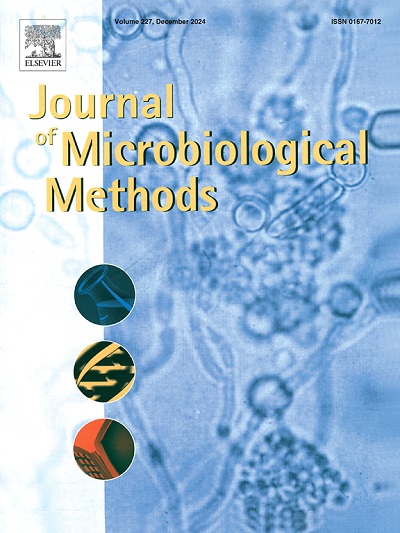Evaluation of digital PCR for the detection of bovine viral diarrhea virus in persistently infected cattle
IF 1.9
4区 生物学
Q4 BIOCHEMICAL RESEARCH METHODS
引用次数: 0
Abstract
Bovine Viral Diarrhea Virus (BVDV) is a significant pathogen of cattle, causing substantial economic losses. Identifying persistently infected (PI) animals is crucial for BVD control and prevention, with pooled ear-notch tissue testing being a standard screening method. Digital PCR (dPCR) is an emerging diagnostic tool that provides absolute quantification of animal pathogens in low abundant targets. This study evaluates the effectiveness of dPCR for BVD surveillance using field submissions of pooled ear-notch samples, comparing it to real-time quantitative reverse transcription PCR (qRT-PCR). The study compared performance using 107 pools of ear notches (4853 sample animals), including 76 BVD-positive pools (3543 sample animals) and 31 BVD-negative pools (1310 sample animals). Pools included those that contained PI animals detected by IHC (n = 25) and those with only virus detection that were negative by IHC (n = 51). Performance metrics evaluated included analytical and diagnostic sensitivity and specificity, limit of detection (LOD) and test agreement with qRT-PCR. Results showed that dPCR exhibited enhanced sensitivity and lower LOD compared to qRT-PCR, detecting as low as 0.6 viral copies/μL. dPCR achieved 100 % sensitivity (76/76) and 96.77 % specificity (30/31) compared to qRT-PCR and no detection of common bovine pathogens. The comparison between qRT-PCR and dPCR using Cohen's kappa coefficient in pooled samples was 0.98, indicating almost perfect agreement. In pooled ear-notch samples with qRT-PCR quantification cycle (Cq) values ranging from 30 to 33.99, the viral load ranged from 4.75 to 194.78 viral copies/μL. The study suggests that dPCR is a sensitive and specific method for detecting BVD in pooled ear-notches.

持续感染牛的牛病毒性腹泻病毒数字PCR检测方法的评价
牛病毒性腹泻病毒(BVDV)是牛的重要病原体,造成巨大的经济损失。识别持续感染(PI)的动物对于BVD的控制和预防至关重要,合并耳口组织检测是一种标准的筛查方法。数字PCR (dPCR)是一种新兴的诊断工具,它提供了动物病原体在低丰度目标的绝对定量。本研究评估了dPCR在BVD监测中的有效性,并将其与实时定量反转录PCR (qRT-PCR)进行了比较。该研究使用107个耳槽池(4853只样本动物)进行性能比较,其中76个bvd阳性池(3543只样本动物)和31个bvd阴性池(1310只样本动物)。池中包括经免疫组化检测的PI动物(n = 25)和仅经免疫组化检测的病毒阴性动物(n = 51)。评估的性能指标包括分析和诊断敏感性和特异性,检测限(LOD)以及与qRT-PCR的测试一致性。结果表明,与qRT-PCR相比,dPCR具有更高的灵敏度和更低的LOD,检测到的病毒拷贝数低至0.6个/μL。与qRT-PCR相比,dPCR的灵敏度为100%(76/76),特异性为96.77%(30/31),未检测到牛常见病原体。在合并样本中,采用Cohen’s kappa系数比较qRT-PCR与dPCR的结果为0.98,几乎完全一致。在qRT-PCR定量循环(Cq)值为30 ~ 33.99的合并耳沟样品中,病毒载量为4.75 ~ 194.78病毒拷贝/μL。该研究表明,dPCR是一种灵敏、特异的检测耳沟BVD的方法。
本文章由计算机程序翻译,如有差异,请以英文原文为准。
求助全文
约1分钟内获得全文
求助全文
来源期刊

Journal of microbiological methods
生物-生化研究方法
CiteScore
4.30
自引率
4.50%
发文量
151
审稿时长
29 days
期刊介绍:
The Journal of Microbiological Methods publishes scholarly and original articles, notes and review articles. These articles must include novel and/or state-of-the-art methods, or significant improvements to existing methods. Novel and innovative applications of current methods that are validated and useful will also be published. JMM strives for scholarship, innovation and excellence. This demands scientific rigour, the best available methods and technologies, correctly replicated experiments/tests, the inclusion of proper controls, calibrations, and the correct statistical analysis. The presentation of the data must support the interpretation of the method/approach.
All aspects of microbiology are covered, except virology. These include agricultural microbiology, applied and environmental microbiology, bioassays, bioinformatics, biotechnology, biochemical microbiology, clinical microbiology, diagnostics, food monitoring and quality control microbiology, microbial genetics and genomics, geomicrobiology, microbiome methods regardless of habitat, high through-put sequencing methods and analysis, microbial pathogenesis and host responses, metabolomics, metagenomics, metaproteomics, microbial ecology and diversity, microbial physiology, microbial ultra-structure, microscopic and imaging methods, molecular microbiology, mycology, novel mathematical microbiology and modelling, parasitology, plant-microbe interactions, protein markers/profiles, proteomics, pyrosequencing, public health microbiology, radioisotopes applied to microbiology, robotics applied to microbiological methods,rumen microbiology, microbiological methods for space missions and extreme environments, sampling methods and samplers, soil and sediment microbiology, transcriptomics, veterinary microbiology, sero-diagnostics and typing/identification.
 求助内容:
求助内容: 应助结果提醒方式:
应助结果提醒方式:


